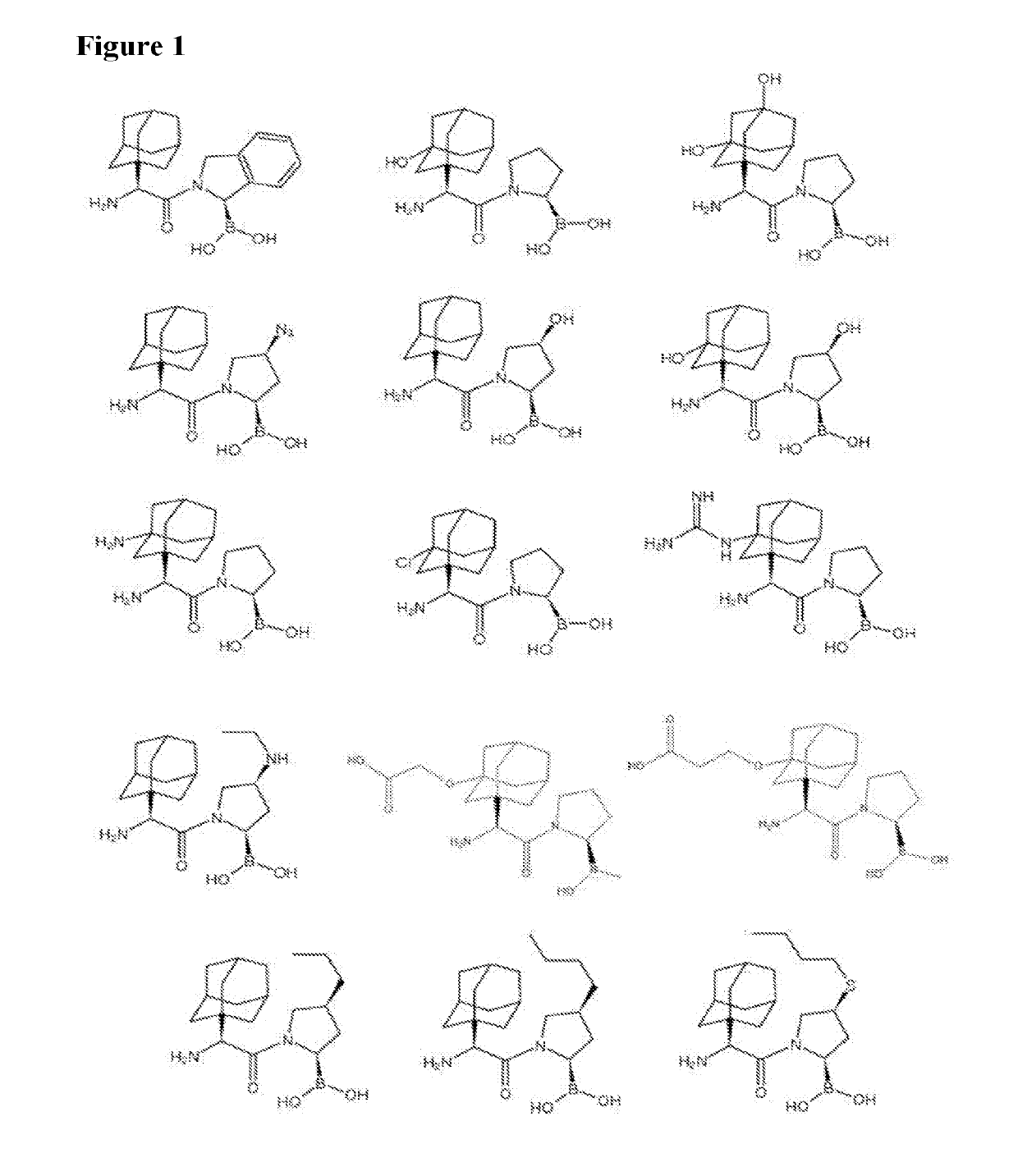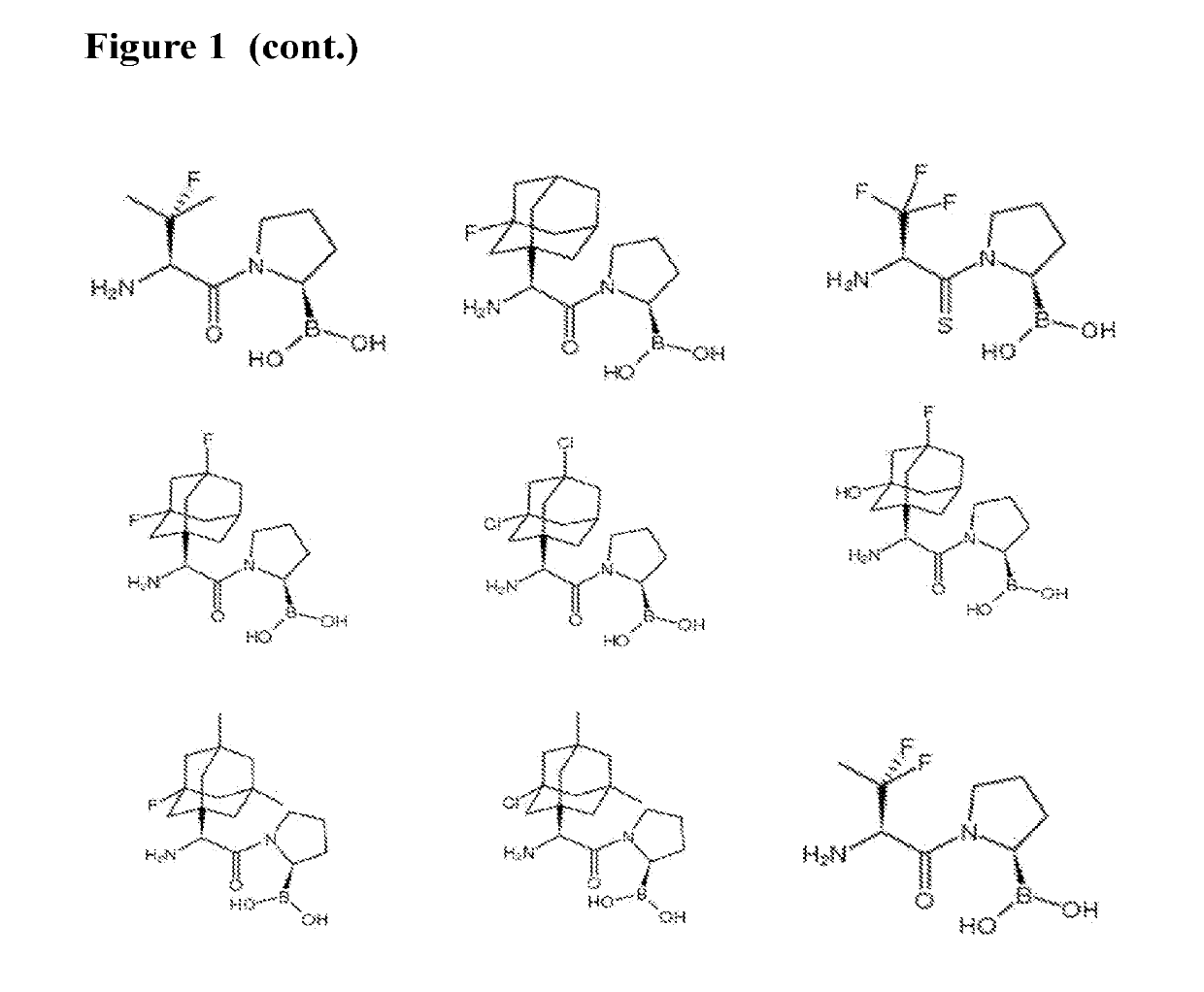Dash inhibitors, and uses related thereto
a technology inhibitors, which is applied in the field can solve the problems of dpp8/9 specific inhibitors producing profound toxicity, multiple histological pathologies, and mortality, and achieves the effects of improving the maximum tolerated dose, reducing the dose, and improving the efficacy rate and/or complete response ra
- Summary
- Abstract
- Description
- Claims
- Application Information
AI Technical Summary
Benefits of technology
Problems solved by technology
Method used
Image
Examples
example 1
Scheme
[1613]Synthesis of the compounds of the invention may involve a coupling reaction using a coupling reagent, such as HATU, etc, followed by de-protection when necessary, using, for example a reagent such as BCl3 or HCl-PhB(OH)2 method when necessary. Some of the target compounds were purified by RP-HPLC using Varian semi-preparative system with a Discovery C18 569226-U RP-HPLC column. The mobile phase was typically made by mixing water (0.1% TFA) with acetonitrile (0.08% TFA) in gradient concentration. The compound code, structure and characterization are shown in Table 1.
Exampled Synthetic Procedures of Gly(1-adamantyl)-boroPro (ARI-5544 or 3102A-2C)
[1614]
Synthesis of Gly(1-adamantyl)-boroPro (ARI-5544)
[1615]A solution of 4 N HCl (g) in dioxane (5 mL, 20 mmol) was added to Compound 1 (0.86 g, 1.6 mmol) under dryice / acetone cooling and then was allowed to stir for 3 hrs at room temperature. The reaction mixture was concentrated under reduced pressure and then co-evaporated with...
exampled
Synthetic Procedures of 3102C
[1617]
Synthesis of 3102C
[1618]Starting from N-Boc-L-3-hydroxy-1-Adamantyl-Glycine with the similar coupling reaction described above for the preparation of 1, compound 2 was prepared. This product (0.28 g, 0.5 mmol) was dissolved in dry dichloromethane (5.0 mL) and cooled to −78° C. while BCl3(1 M in dichloromethane, 5.0 mL) was added dropwise. The mixture was stirred at −78° C. for 1 hr, brought to room temperature and then concentrated in vacuo. The residue was partitioned between ether (5 mL) and water (5 mL). The aqueous layer was washed twice with more ether (2×5 mL), concentrated in vacuo and further purified by semipreparative RP-HPLC to give 3102C as a TFA salt (0.13 g, 55%).
Synthesis of 5870
[1619]Synthetic Scheme: i. DAST; ii. LiOH; iii. L-boroPro-pn, HATU, DIEA; iv. BCl3.
Synthesis of 5871
[1620]Synthetic Scheme: i. Mel, K2CO3, DMF; ii. 4 eq. DAST and high temperature; iii. LiOH; iv. L-boroPro-pn, HATU, DIEA; v. HCl then PhB(OH)2.
Synthesis of 587...
example 2
DASH-inhibitors
[1627]The following table provides, in columns 3-7, the inhibitory IC50's as determined for cell-free preparations of DPP8, DPP9, DPP4, DPP2, FAP (fibroblast activating protein) and PREP. These IC50 values (in nM) were determined following the protocol set forth in Example 4 below. See also FIGS. 11 and 15. Where calculated, the table also provides the intracellular IC50 (“IIC50”) for inhibition of DPP8 and DPP9 in whole cells, according to the protocol described in Example 3 below. In certain instances, the table also provides the IC50 for inducing pyroptosis of macrophages in cell culture.
CmpdIIC50IDStructureDPP8DPP9DPP4DPP2FAPPREPDPP8 / 9Pyroptosis55447.86.16.42731424.71.73102C5462120152.7NA4175CH5.42.72.85476345.86.04175CP5.35.62.99.2886827334268101412687523278753624.52.40.567581200110NA494924192239120058NA19003102A1077.2819491200NA53201.97.9207053,940>100,00089,450280NA534925031009261014,000730NANA53635.55.21.4110321400270NA43675.61.51.43435020055NA58709.78.49.3583...
PUM
 Login to View More
Login to View More Abstract
Description
Claims
Application Information
 Login to View More
Login to View More - R&D
- Intellectual Property
- Life Sciences
- Materials
- Tech Scout
- Unparalleled Data Quality
- Higher Quality Content
- 60% Fewer Hallucinations
Browse by: Latest US Patents, China's latest patents, Technical Efficacy Thesaurus, Application Domain, Technology Topic, Popular Technical Reports.
© 2025 PatSnap. All rights reserved.Legal|Privacy policy|Modern Slavery Act Transparency Statement|Sitemap|About US| Contact US: help@patsnap.com



